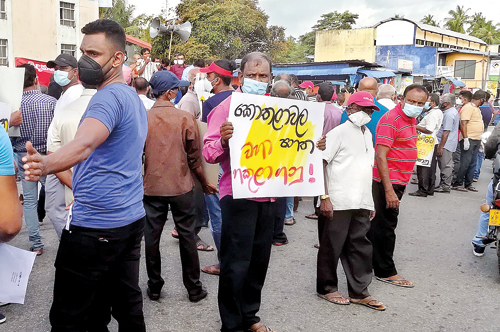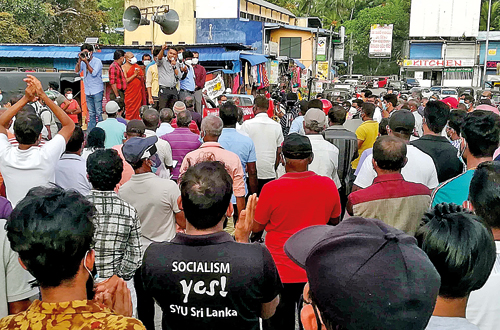News
KDU running on borrowings: National Audit Office
Among the Kotelawala Defence University’s (KDU) borrowings over the years is a foreign currency loan of US$ 177.33mn (Rs 35bn) in addition to a local currency loan of Rs 3.16bn obtained from the National Savings Bank (NSB) on a Treasury guarantee in April 2013, documents show.

Yesterday's protest against the KDU bill at Kiribathgoda. Pic by Nilan Maligaspe
The KDU experienced a steep deterioration in its debt-to-equity ratio. According to the National Audit Office (NAO), in 2018 the ratio stood at 3.5:1. It worsened in 2019 to 3.7:1. The NAO pointed specifically to the “high-debt-to equity ratio in relation to the institute”.
A debt-to-equity ratio shows the proportions of equity (value that would be returned to a company’s shareholders if all of the assets were liquidated and all of the company’s debts were paid off) to debt a company is using to finance its assets. A high debt-to-equity ratio, as shown in KDU’s case, indicates a company is getting more of its financing by borrowing money.
The NAO also says that the ratio for current liabilities-to-current assets in the year 2018 was 1.9:1 percent. The following year it declined sharply to 2.6:1. The liabilities-to-assets ratio is a solvency ratio that examines how much of a company’s assets are made of liabilities. A company facing declining revenues and poor long-term prospects of growth will be impacted on retained equity.
Annual audits show how the KDU’s finances have deteriorated. For instance, the 2018 NAO report states that the debt-to-equity ratio in 2017 was 1:2.84, which is a positive indicator. In 2018, it was still 1:3.51.
The 2021 budget estimate allocates KDU and the Teaching Hospital a total of Rs 7.9 bn, of which Rs 5.5bn is for payment of past loans.
The last publicly available annual report of the KDU is dated 2017. It reveals that the University was to have settled the loan completely by the end of 2033, starting 2018, using “incomes it generates”. “However, it was observed that the repayment of the above-mentioned loan was problematic as there was a deficit in the financial outcome of the University from the year 2013 to the year under review,” it states.
 The NAO reveals that KDU obtained the dollar and rupee loans to construct its Teaching Hospital from the National Savings Bank in 2013. A new agreement was signed in September 2018 to restructure the above loan. Accordingly, out of the original sum, US$ 82.33mn (Rs 16bn) was converted to Sri Lankan rupees. It was consented also to convert the remainder of US$ 95mn (Rs 19bn) to 11 installments in Sri Lankan rupees.
The NAO reveals that KDU obtained the dollar and rupee loans to construct its Teaching Hospital from the National Savings Bank in 2013. A new agreement was signed in September 2018 to restructure the above loan. Accordingly, out of the original sum, US$ 82.33mn (Rs 16bn) was converted to Sri Lankan rupees. It was consented also to convert the remainder of US$ 95mn (Rs 19bn) to 11 installments in Sri Lankan rupees.
Further, Rs 627.09mn in interest payable, and Rs 617.47mn in exchange losses, which the bank had to bear in exchange were added to the loan capital, the NAO says. However, the Treasury had agreed to pay interest and loan installments of the above loan from the year 2023 onwards. The KDU consented to pay the local currency loan balance of Rs 3.1bn and interest payable on the loan of Rs 90.83mn within nine years from 2023. In this manner, the creditors-to-equity ratio was increased, the NAO says.
The University was to pay the loan completely by the end of the year 2033, and starting from the year 2018, the University should pay it using the income it generates. However, it was observed that the repayment of the above-mentioned loan was problematic as there was a deficit in the financial outcome of the University from the year 2013 to the year under review.”
The NSB Annual Report converted Rs 27bn worth of outstanding loans of KDU as debentures (covered by Treasury guarantee) in March last year. Therefore, it has been classified from loans and advances to debt and other instruments as at 31 December, 2020.
Financing of KDU has, therefore, been via large loans backed by Treasury guarantees and rollover of such debt. There is little indication of how these loans will be paid: fee-levying students, medical services or taxpayers.

